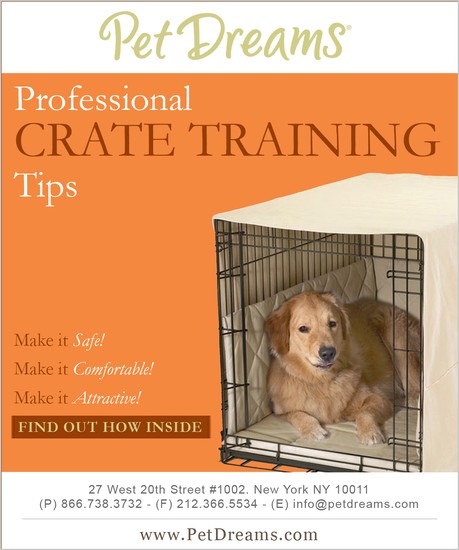Crate Training Tips
Crate Training Frequently Asked Questions
- Why should I crate train my dog?
- What is crate training?
- What about housebreaking older senior dogs?
- How long do I need to use the crate?
- How safe is crate training?
- If my dog wears a collar in his crate, he is at risk for possible strangulation?
- My dog has gotten a bloody nose in the crate. What's happening?
- What are crate sores?
- My dog has broken teeth from chewing on his crate's bars. Is there anything that can prevent this?
- What's the safest way to travel with my dog?
- I was told that dogs like their crates, so why do I have to force mine inside?
- I heard that wire crates are best because they allow the dog to see out. Is this true?
- How do I stop my dog from whining or barking at the crate?
- Will my dog chew up his Cratewear crate bedding?
- Where can I learn more about crates and housebreaking puppies?
- What's in it for me?
Why should I crate train my dog?
Crate training is the fastest and most humane method of housebreaking puppies. Have you ever seen a dog under a table, chair or bed? Believe it or not dogs naturally want to seek shelter, even in a house. If you don't provide it, they will create it themselves in an effort to feel safe and secure. A crate serves as a den for your dog.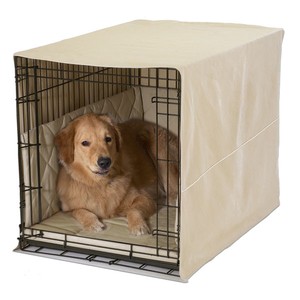
In fact, crate training is the fastest and most humane method of housetraining! The crate training tips/FAQs will help you and your dog minimize frustrations and achieve desired results FAST!
Back to Top
What is crate training?
Like babies, puppies cannot control their bladders until they mature (usually between 3 and 6 months). Lucky us, dogs have a natural instinct to avoid eliminating in their dens. Therefore, confining your puppy in his crate for the proper amount of time encourages him to "hold it" until you take him outside for a walk. Here is a FREE step by step guide on housebreaking and crate training puppies (including the rules of crate training and additional crate training tips).
Back to Top
What about housebreaking older dogs?
It is never too late to crate train your dog! The number one reason dogs end up in shelters is behavior problems. Crate training, at any age, can help break bad habits and solve most of these problems.
Did you know: The Pet Dreams line of Cratewear dog bedding is a great way to reward your puppy as he succeeds in his house-training! Soft, comfortable and safe for dogs large and small you'll never look back on your boring old kennel again! But don't just take our word for it.
Back to Top
How long do I need to use the crate?
Crates are not just for training, they are good for all life stages! By providing a crate for your dog, you are in essence providing him with his own bedroom. Crates are especially important for older dogs that use it to escape the hustle and bustle of everyday family life, which often includes small children or other pets that may harass them.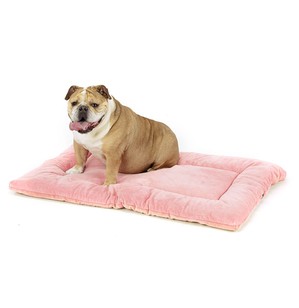
How safe is crate training?
Dog crates are the best housetraining tool available. They provide a room for your dog while protecting your home furnishings from damage. However, even a crate isn't an absolute safe harbor for your pet. As per crate manufacturers warnings, you should always remove standard collars before placing your dog in a crate. The only collar we recommend as being safe when inside a crate is Premier's "KeepSafe" break-away collar. Otherwise, your dog is at risk for possible strangulation if his collar or ID tags become caught in the crate's bars. Cratewear bumpers are the only bumpers made high enough to help prevent collar strangulation and other crate-related injuries.
Crates are not just for training!
Did you know: If your dog wears a collar in his crate, he is at risk for possible strangulation!
Back to TopI noticed loss of fur on the end of my dog's tail. What causes this?
Dogs have powerful tails and believe it or not they have no control over their wagging! Dogs will wag for many different reasons. Therefore, some dogs wag their tails against the crate's metal bars repeatedly, which causes discomfort and sometimes injury. Injuries like this can be quite painful and they are not always obvious. Even when he is in pain, your dog won't be able to stop wagging. This can also lead your dog to not like his crate, which disrupts the housetraining process. Cratewear bumpers prevent this type of crate-related injury.
Protect your dog's tail when he can't!
My dog has gotten a bloody nose in the crate. What's happening?
Some dogs instinctively like to "burrow" or dig with their noses. When they do this in a metal wire kennel, their nose can become raw or bloody. Cratewear crate pads and bumpers will prevent this type of common crate-related injury.
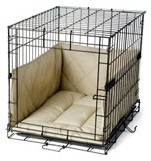
Did you know: Cratewear bumpers are the only bumpers made high enough to prevent crate-related injuries.
Back to Top
What are crate sores?
Most dogs like to curl up against something when they lie down and they end up lying against the crate's metal bars. This rubbing and contact with the metal can cause hair loss and sores, especially in larger breeds. Cratewear bumpers prevent such irritations.
Back to Top
My dog has broken teeth from chewing on his crate's bars. Is there anything that can prevent this?
Always make sure there are appropriate toys & treats to keep your dog's attention in the crate. Cratewear bumpers help protect his teeth from the wire bars and can be sprayed with a taste deterrent like Bitter Apple. It's better to chew on a toy or on a Cratewear bumper than to chew the crate's metal bars, which can result in expensive veterinary bills and permanent tooth damage.
Back to Top
What's the safest way to travel with my dog?
In the car a crate can provide safety for you, your dog, and your passengers. Cratewear bumpers provide comfort and protect your dog during sudden stops and turns. What's more, it allows you to take your dog's "bedroom" with you wherever you go, so your dog will be more at ease in different environments whether in a dog kennel or hotel. Cratewear crate pads can be used in or out of the kennel and are also easily transportable. Metal wire crates are not recommended for airplanes, so you should use a plastic carrier if you intend to fly with your dog, and be sure to consult your airline's regulations.
Did you know: Crate covers can reduce barking and stress
Back to Top
I was told that dogs like their crates, so why do I have to force mine inside?
There are many reasons to not enjoy a bare metal dog cage:
Comfort: when dogs lie down in their crates, they are leaning up against wire bars, which can be very irritating. Cratewear's quilted bumpers provide the comfort they need while also protecting their coats, wagging tails, noses and teeth from the metal. What's more, itss reversible and machine washable crate pads add comfort he'll appreciate.
Security: wire crates leave your dog exposed on all sides. Crate covers provide den like security.
Location: separating your dog from the rest of the family can add stress to your dog. Dogs are social animals, so the ideal location is a room full of activity. Your dog will enjoy his new room while still being part of the family. At night the bedroom is an ideal place for a crate so your dog will feel the security of being close to you.
Time: confining him in his crate for excessive periods of time will be a negative experience for your dog. After housebreaking your dog, we recommend removing the door from the crate so he can enjoy his den any time he chooses.
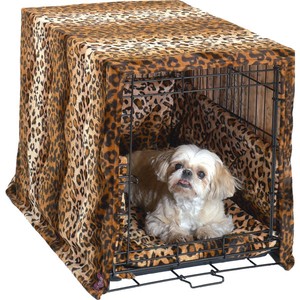
Did you know: Top veterinarians and dog trainers recommend covering your dog crate
Back to TopSome things you can do to make dog crates and kennels more appealing:
- Use Cratewear to make his crate safe & comfortable
- Put appropriate toys and treats inside the crate, which will entice him to go in on his own.
- Feeding your dog in his crate can develop a positive association with it.
- Give your puppy lots of praise when he enters the crate.
I heard that wire crates are best because they allow the dog to see out. Is this true?
Top veterinarian behaviorists and dog trainers recommend covering the crate. This makes the crate a more den-like environment, providing more security, which reduces barking. Covering the crate will result in a better experience for both you and your dog.
Very few dogs exhibit a desire to chew their own personal dog beds.
Back to TopHow do I stop my dog from whining or barking the crate?
Again, make sure the crate is in a good location. Veterinarians and trainers recommend covering the crate to give your dog the privacy he needs to feel secure. If your dog can see you, he'll want to be with you outside the crate. Crate covers lower the number of distractions your dog sees, which reduces barking and stress. Note: Dogs that suffer from separation anxiety should not be crated. If you feel your dog is suffering from separation anxiety and is showing clinical signs, please avoid crating him until speaking to a professional.
Back to TopWill my dog chew up his Cratewear?
Very few dogs exhibit a desire to chew their own personal beds. Always make sure there are appropriate toys & treats to keep your dog's attention in the crate. Cratewear bumpers help protect his teeth from the wire bars and can be sprayed with a taste deterrent like Bitter Apple. It's better to chew on a toy or on a Cratewear Bumper than to chew the crate's metal bars, which can result in expensive veterinary bills and permanent tooth damage.
Back to TopWhere can I learn more about crates and housebreaking puppies?
Our Free Crate Training Puppies guide, which is endorsed by veterinarians and dog trainers, is a great resource that includes step-by-step instructions and crate training tips.
Back to TopWhat's in it for me?
Dog crates give your dog a place he can claim as his territory, we just want to make sure it doesn't interfere with yours. Providing your dog with a comfortable room of his own will help keep him off your furniture. In addition to the safety and comfort benefits for your dog, Cratewear will enhance your wire crate to fit your decor, making the crate an attractive addition to any room. Cratewear is durable and fully machine washable!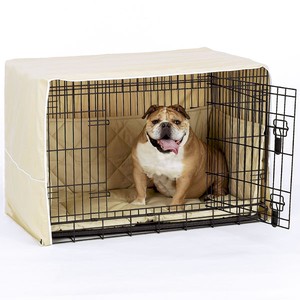

 Track Your Order
Track Your Order